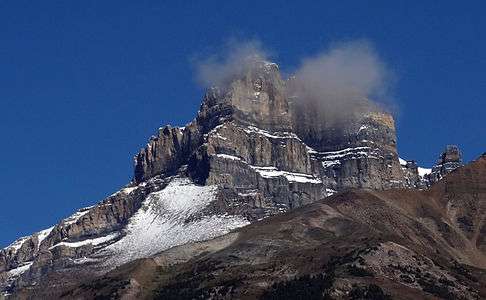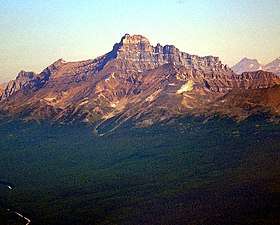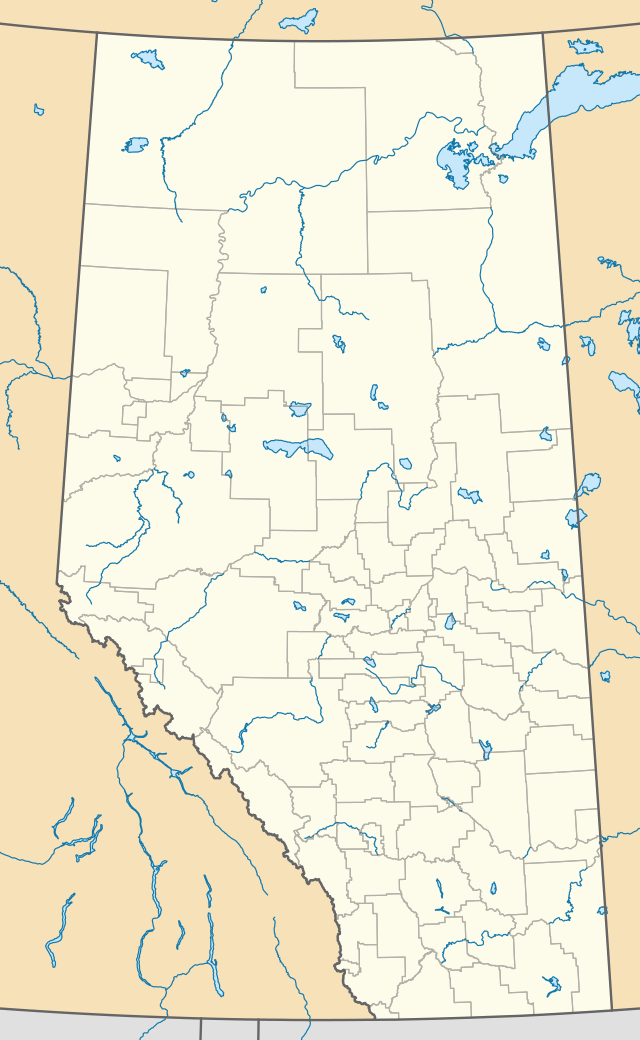Mount Hector (Alberta)
Mount Hector is a 3,394-metre (11,135-foot) mountain summit located in the Bow River valley of Banff National Park, in the Canadian Rockies of Alberta, Canada. The mountain was named in 1884 by George M. Dawson after James Hector, a geologist on the Palliser expedition.[4][5] The mountain is located beside the Icefields Parkway, 17 km (11 mi) north of Lake Louise.
| Mount Hector | |
|---|---|
 | |
| Highest point | |
| Elevation | 3,394 m (11,135 ft) [1][2][3] |
| Prominence | 1,759 m (5,771 ft) [1] [2](Kicking Horse Pass) |
| Parent peak | Mount Victoria[2] |
| Listing |
|
| Coordinates | 51°34′24″N 116°15′30″W [1] |
| Geography | |
| Parent range | Murchison Group |
| Topo map | NTS 82N/09 |
| Geology | |
| Age of rock | Cambrian |
| Type of rock | Sedimentary rock |
| Climbing | |
| First ascent | 1895 |
| Easiest route | rock/snow/glacier climb |

The first ascent was made in 1895 by Philip S. Abbot, Charles Fay and Charles S. Thompson.[2]
Geology
Like other mountains in Banff Park, Mount Hector is composed of sedimentary rock laid down during the Precambrian to Jurassic periods.[6] Formed in shallow seas, this sedimentary rock was pushed east and over the top of younger rock during the Laramide orogeny.[7]
Climate
Based on the Köppen climate classification, Mount Hector is located in a subarctic climate with cold, snowy winters, and mild summers.[8] Temperatures can drop below −20 °C with wind chill factors below −30 °C. Precipitation runoff from Mount Hector drains into tributaries of the Bow River.
See also
References
- "British Columbia and Alberta: The Ultra-Prominence Page". Peaklist.org. Retrieved 2012-12-23.
- "Mount Hector". Bivouac.com. Retrieved 2019-05-10.
- Bow Lake and Ssskatchewan Crossing (Map) (2nd ed.). 1:70,000. Cochrane, AB: Gem Trek Publishing. 2000. ISBN 1-895526-10-8. Retrieved 2019-06-25.
- "Mount Hector". PeakFinder.com. Retrieved 2019-06-25.
- Place-names of Alberta. Ottawa: Geographic Board of Canada. 1928. p. 63.
- Belyea, Helen R. (1960). The Story of the Mountains in Banff National Park (PDF). parkscanadahistory.com (Report). Ottawa: Geological Survey of Canada. Archived (PDF) from the original on 2015-10-02. Retrieved 2019-09-13.
- Gadd, Ben (2008). "Geology of the Rocky Mountains and Columbias". Missing or empty
|url=(help) - Peel, M. C.; Finlayson, B. L. & McMahon, T. A. (2007). "Updated world map of the Köppen−Geiger climate classification". Hydrol. Earth Syst. Sci. 11: 1633–1644. ISSN 1027-5606.

